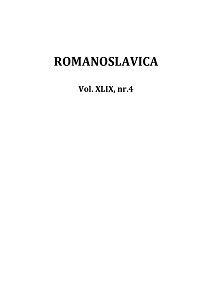Czas w kulturze, czyli o ludowych nazwach miesięcy okresu wiosenno‐letniego w Rumunii
Time in culture, or the folk names of the months of the spring and summer period in Romania
Author(s): Ewa KocójSubject(s): Customs / Folklore, Cultural Anthropology / Ethnology, Sociology of Culture, Eastern Orthodoxy
Published by: Editura Universităţii din Bucureşti
Keywords: time in culture; folk calendar; Romania; the name of month; spring‐summer period; culture translation;
Summary/Abstract: The category of time functioning in individual cultures as well as calendars – the corresponding systems of time classification, can be perceived as examples of cultural phenomena. They prove to be extremely interesting, but at the same time difficult to analyze. In many cases the circumstances are quite complicated as there are various methods of measuring time within individual cultures. They correspond to the national, secular calendars, the official religion, the calendars of minority faiths as well as the so‐called folk tradition. The purpose of this article is to analyze the names of the months functioning in the Romanian folk culture in the context of the official names of months present in the Romanian language. Cultural anthropology, supported by the idea of research on cultural senses and meanings as well as the inter‐translation among them denotes that the traditions presented vary, are incoherent and refer to various sources. However, for a few centuries they were undergoing a process of formulation within one cultural domain. The fundamental issue for an anthropologist is to be convinced that a proper linguistic translation cannot be conducted unless the senses and meanings of a given culture are quite profoundly penetrated. The ethno linguistic as well as cultural analyses plainly indicate that behind the contemporary division into twelve months there might be another, an even older tradition of time classification. A part of the folk nomenclature is of very distant provenience; it is known to have been present in the religious texts around the Romanian land as long ago as at least the second half of the 16th century. The nomenclature corresponded to the phenomena observed in nature, changes of seasons and the vegetation cycle of plants. Other functioning names mentioned household activities, agricultural labour performed in the fields and the village life. The names of months as well as weeks within them encompass many mythological aspects. They refer to people’s beliefs and significant personas of the folk pantheon. The names also relate to religious attributes associated with saints from liturgical calendar and the customs as well as rituals of the Orthodox performed at a given time of year. They were a result of a different perception of time – not linear and historical, but rather cyclical, making a full circle during the year. Despite the fact that folk culture is slowly disappearing and the global influence is gaining momentum, folk names of months are still present in the contemporary official language of the Orthodox Church as well as within the popular culture.
Journal: Romanoslavica
- Issue Year: XLIX/2013
- Issue No: 4
- Page Range: 79-92
- Page Count: 14
- Language: Polish

